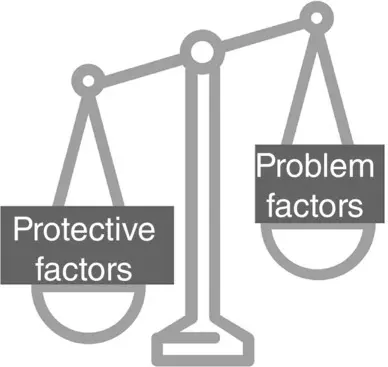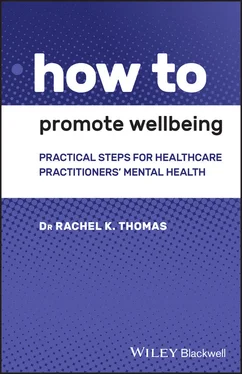Hence, it is essential for us to protect our own wellbeing, in order to be able to provide the highest quality of care to our patients. This, in itself, is sufficient motivation. Besides, if we are unwell, we, ourselves, may become a burden on the very healthcare system we are trying to uphold – and negatively impact on workloads, both our own and our colleagues. In any event, by signing up to as clinicians and other healthcare professionals, we have already agreed in principle to protect our own wellbeing through our relevant codes of conduct and ethics.
Why should we consider both problem factors and protective factors?
‘Mental health’ and ‘wellbeing’ appear, on the surface, to be influenced by somewhat nebulous factors. Without teasing these factors out, it is difficult to know how to start tackling them. We can give ourselves a ‘road map’ to follow by categorising the factors as either problem or protective. We then have indications of where and how we should direct our attention. There are some problem factors that will always be present, just as there are some protective factors which will never be adequate. With increased awareness, we can start tipping the scales into more balance than has historically been the case, resulting in overall improvement in our mental health and wellbeing ( Figure 0.2).

Figure 0.2 Balancing problem and protective factors.
Being physically fit will not categorically prevent illness, and similarly, improving mental resilience and stress management will not categorically avoid burnout. The techniques suggested in this book are useful tools to employ to try to help prevent burnout. These techniques are not a ‘cure all’, and by using them, all stress and burnout may not necessarily be avoided. If we are unable to avoid burnout, it may not necessarily be due to not having taken enough steps, or not having carried them out assiduously enough. As with physical illness, increasing physical fitness and improving lifestyle aspects, such as nutrition, improve the chances of returning to ‘normal functioning’ after physical illness and treatment, and decrease the chances of falling ill in the first place. So, too, may the steps in this book improve our chances of strengthening our resilience and if stressed, returning to mental wellness; and potentially decrease our chances of succumbing to stress in the first place.
When the cost of doing nothing is so high, what have we got to lose?
Chapter 1 General problem factors affecting global mental health and wellbeing
While our individual mental health and wellbeing are influenced by many factors, so too is that of the overall state of mental health across the globe. The following overview provides a lens through which we can reflect on key aspects.
Problem factor: Global mental health burden
The global burden of mental health conditions is greater than both cancer and cardiovascular disease. 1Approximately a third of adult health problems and disability across the globe is due to mental illness challenges. 2Such an enormous global burden has meant that finding solutions to the problem has become a key priority in many countries. The emphasis is now increasingly on potential preventative measures and early, lighter touch interventions, more than ever before.
The average time to treatment after mental health symptoms first appear has been estimated as 10 years, and that two out of every three people who are depressed will not receive care that is adequate. 3This global crisis has prompted many conversations, as well action plans from institutions such as the World Health Organisation (WHO).
Conversations on mental health issues concerning the general population, a useful starting point for addressing the mental health burden, are increasing in the community. However, these conversations are lagging when it comes to clinicians reflecting on mental health issues in themselves. It is ironic that we instigate and support such conversations, yet – for various reasons as we will discuss – are left with either little insight, or little capacity, for action in regard to ourselves .
With these conversations about both the general population and clinicians alike, it is key to remember that mental health conditions are not the fault of the person who is affected by them. Much as we do not blame someone with asthma for having it, we need to ensure that conversations on mental health issues – be they involving clinicians or not – do not implicitly blame the person who is affected.
Being affected by stress, burnout, or any other mental health condition is not the fault of the person who is affected .
Burnout, or suffering under the effects of stress, or any other mental health condition, are not due to personal shortcomings and are not due to a failure of some sort in the individual who is affected – whether they are a clinician or not. While this may seem common sense to some of us, on reflection, it may give pause for thought for others.
Burnout can be regarded as a ‘fracture’ or a reaching of ‘breaking point’, and it is important to remember that stress can leave ‘injury’ as it nudges us closer to this point. Just because we have not yet reached breaking point, doesn’t mean that we aren’t being ‘injured’ by the stress. And just because we haven’t been diagnosed with a mental health condition, doesn’t mean that, at times, our mental health is suffering.
Or that our mental health couldn’t be improved.
We spend a significant proportion of our lives working. ‘Workplace stress’ is a common concept in many workplaces, with significant cost associated with many large corporations’ efforts to provide wellbeing tools and support for their staff. Acknowledging the impact of stress from work is thus not dissimilar to that which most of our fellow humans are feeling. Recognised sources of stress in a general workplace include:
A lack of support
Unrealistic demands
A lack of appreciation
An imbalance between effort and reward.4
Working as clinicians, we find that these sources of stress are all too common in our areas of work, too. Yet while it is generally acknowledged that working as a clinician is stressful, the support tools that other occupations are provided with are often lacking for us. Particularly within the existing hospital system of many countries, the stresses of work are also related to the infrastructure that we are working within. They may be due to a range of factors, including excessive workloads, a workplace culture that is unsupportive of lowering stress at work, and other aspects of the overall work environment.
In times of crisis, efforts to expand the healthcare system lead to increases in these stresses. Doctors being moved to areas of practice where they have lesser familiarity working in – some even returning from retirement – leads to increases in stress. Inadequate personal protective equipment (PPE) and staffing rotas lead to clinicians being put in positions that can harm not only their own health but that of their patients, too. There is often an ‘all systems go’ approach to handling crises, while the ‘recovery’ or ‘debrief’ phases of such times are often viewed as being less important. After periods at war, the returned servicemen and women have current practice guidelines for debriefing techniques. 5Given their exposure to death and suffering during their work, it is well recognised that some kind of support will benefit them once they return. We, as clinicians, are also constantly surrounded by death and suffering and may be physically and mentally stretched beyond our coping resources. We are trained to manage both patients and our feelings about their health in times of crisis, but perhaps current practice guidelines should afford us similar support. Reflecting on the support offered in corporate environments may highlight that mental health education and stress management support is offered more extensively there, too, than it is for healthcare professionals.
Читать дальше













